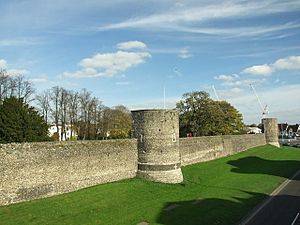James Hales facts for kids
Sir James Hales (born around 1500 – died 1554) was an important English judge from Kent. He was the son of another famous judge and politician, John Hales.
Even though Sir James was a Protestant, he refused to sign a document in 1553 that would have made the Protestant Lady Jane Grey queen. Later, when the Catholic Queen Mary came to power, he spoke out against making laws less strict for people who didn't follow the official religion.
A famous court case involving his family, Hales v. Petit, is even thought to have inspired a scene in Shakespeare's play Hamlet, specifically the conversation between the gravediggers after Ophelia drowns.
Contents
Sir James Hales: Early Life and Career
Sir James Hales was the oldest son of John Hales, who was a judge in the Court of Exchequer and owned a large estate called The Dungeon in Canterbury. His mother was Isabel Harry.
Sir James studied law at Gray's Inn, a famous law school in London, between 1517 and 1519. By 1530, he was working as a lawyer in the Court of Requests, which handled legal problems for ordinary people. In 1532, he became a senior member of Gray's Inn.
Becoming a Royal Advisor
In 1541, Sir James became a legal advisor for the city of Canterbury. He also advised Archbishop Thomas Cranmer, a very important religious leader at the time.
In 1544, King Henry VIII appointed him as a King's Serjeant, a high legal position. The King also gave him a large estate called Clavertigh in Elham.
When King Edward VI became king in 1547, Sir James was made a Knight of the Order of the Bath. In 1549, he was appointed a Justice of the Common Pleas, which meant he became a judge in one of England's main courts.
Sir James Hales: Faith and Challenges
Sir James Hales strongly supported the Protestant Reformation, which was a big change in the Christian church in England. In 1551, he was part of the group that removed Bishop Stephen Gardiner from his position.
Refusing to Support Lady Jane Grey
In 1553, there was a big political crisis. John Dudley, 1st Duke of Northumberland tried to make the Protestant Lady Jane Grey queen instead of Mary, who was King Henry VIII's daughter. Sir James Hales was one of only three judges who refused to sign the document that would have made Lady Jane Grey queen.
Standing Up to Queen Mary
When Mary became queen, she was a Catholic and wanted to bring back the Catholic faith to England. Many people expected the strict laws against Catholics to be relaxed. However, Sir James Hales bravely pointed out to a jury in Kent that these laws were still in place. He insisted that the jury must follow the law exactly as it was written at that time.
Imprisonment and Release
In October 1553, Queen Mary allowed Sir James to keep his job as a Justice. But the Lord Chancellor, Bishop Gardiner, refused to let him take his oath. Instead, Sir James was sent to jail. He was held in several prisons, including the King's Bench Prison and the Fleet Prison. During his time in prison, people tried many times to make him change his mind and become Catholic.
In April 1554, Queen Mary ordered his release. Some stories say she even spoke to him kindly. However, his time in prison had deeply affected his mental health. On August 4, 1554, while staying with his nephew in Thanington, he sadly drowned himself in a shallow stream.
Hales v. Petit: A Famous Lawsuit
In 1558, Sir James Hales's widow started a legal case against Cyriac Petit. She wanted to get back control of some land that had been leased to her and her husband in 1551. This lawsuit became very famous.
The court eventually decided in favor of Petit in 1562. A detailed report of this case was published in 1571 by Edmund Plowden. This case is well-known because of its connection to Shakespeare's Hamlet.
Sir James Hales: Family Life
Sir James Hales was married twice. His first wife was Mary, who was the daughter of Thomas Hales, a merchant from Abingdon.
Their children included:
- Humphrey (died 1571), who married Joyce Atwater. He was the father of another Sir James Hales (died 1589).
- Edward, who also became a lawyer, following his father and older brother.
- Mildred (died 1596), who married Thomas Docwra.
- Mary, who married William Ryther around 1534. She was the mother of James Ryther, who became a Member of Parliament.
- Jane, who married Walter Mantell around 1547. After his death, she married Christopher Carlell.
- Elizabeth, who married John Gayson.
- Frances (born around 1532), who married Walter Hendley in 1554.
His second wife was Margaret, the daughter of Oliver Wood. Margaret had been married twice before. Her first husband was Sir Walter Mantell. Her second husband was Sir William Haute. Margaret died on September 18, 1567, and was buried in St Mildred's Church in Canterbury. There is a monument there to remember her.
Images for kids
-
Monument to Sir James Hales (d.1589) in Canterbury Cathedral, showing the Hales family crest.




